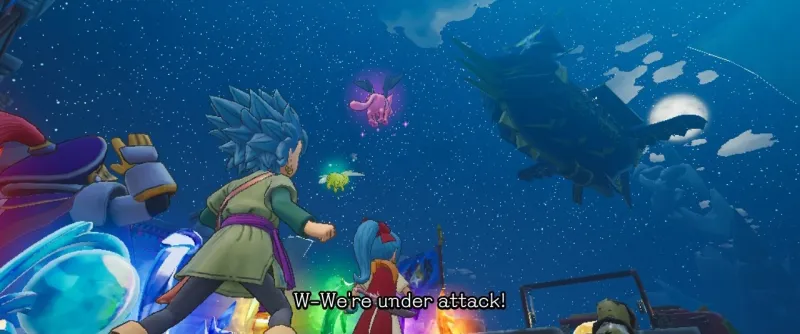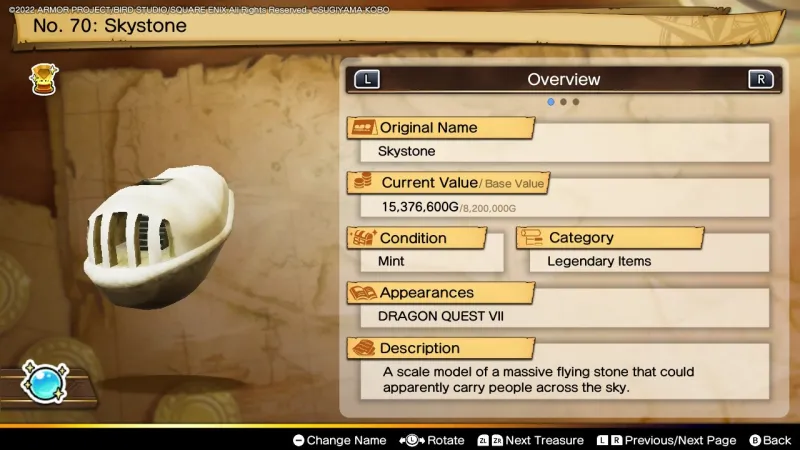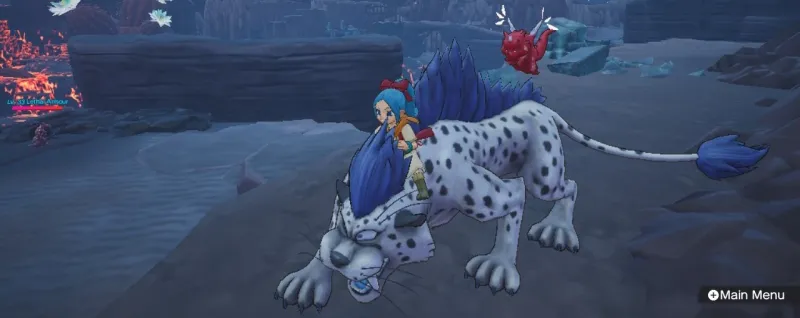Many JRPGs have slow openings, taking their time to establish the story and familiarize the player with the mechanics before letting them loose into the world. I figured that was the case after playing an hour of Dragon Quest Treasures, so I said to myself, “It’ll get good soon!” I said it again two hours in, three hours in, and five hours in, until eventually, I was forced to accept that this was as good as the game would get. Dragon Quest Treasures is never short on charm or style, but simple, sub-par combat and loot-hunting mechanics had me scraping the bottom of the treasure chest in hopes there was something I’d missed.
Players of Dragon Quest XI will recognize protagonists Mia and Erik, though they’re much younger in this game. Dragon Quest Treasures is technically a prequel to XI, but there’s hardly any overlap, and the vast majority takes place after the twins jump through a portal into the mysterious world of Draconia. After getting their bearings and making a few friends, they start a treasure-hunting gang and decide to find all seven Dragonstone, magical relics from Draconia’s origin. While the start of the game is story-heavy, most of my 25 hours of play were self-driven, which I appreciated. The plot isn’t particularly interesting or engaging, but I didn’t need it to be; it’s mainly a vehicle to get the player to explore the islands around them.

The bulk of Dragon Quest Treasures involves exploring open-world islands to hunt for valuables, which can be found buried in glowing spots on the ground. Mia and Erik track it down by using magic Dragon Daggers to see “treasure visions,” glimpses of the landscape near the burial site seen through the eyes of the monsters in your party. You can use these images to triangulate the position of the buried chest and claim it as your own. It’s not a terrible mechanic, but it isn’t complex or engaging enough to base the whole game around. I also encountered multiple instances of items spawning in the same areas upon revisiting an island, which suggests that there’s a finite amount of treasure locations to find.
Once you’ve gathered as many valuables as you can, your goal is to return to base unscathed. Treasure storage capacity is limited, and you drop your current spoils whenever you die. There’s also no fast travel. You can use a button in the menu to return home, but this causes you to drop all your riches, effectively voiding your expedition. You can fast travel without dropping anything if you use a chimera wing, but they’re rare, expendable resources that I kept stashed away for emergencies. These mechanics are all purposefully inconvenient, but they bothered me more in theory than in practice. I rarely died in the field, and I was only forced to use a chimera wing two or three times by the time I finished the game.
Once you return to your hideout and appraise your haul, it reveals a beautiful rendering of a character or item from past Dragon Quest titles. Even though I didn’t recognize many of the items I found, I appreciated this detail a lot, and I’m certain that nostalgia for the series would greatly heighten the experience. And as much as I didn’t really care for the treasure vision mechanic, I can’t deny the satisfaction I felt when I returned to base with a full inventory and uncovered an iconic, expensive relic that I got to add to my hoard.

When you’re not hunting treasure, you’re fighting enemy monsters. Most Dragon Quest games are turn-based, but Dragon Quest Treasures uses seamless, in-world action combat. Unfortunately, the combat is limited and clunky; the attacks at your disposal feel uncomfortable to use, and often caused me to take damage or miss shots. For example, Mia and Erik can attack with their daggers and roll out of the way of enemy offense, but movement in battle is sluggish and cumbersome. Dodge rolls are helpful when you’re watching an enemy strike from afar, but since rolls don’t interrupt dagger attacks, I didn’t have time to evade when I was up close dealing melee damage. As a result, I learned to avoid the dagger in most dangerous situations.
The other weapon you can use is a slingshot loaded with different elemental pellets, but I wasn’t a huge fan of this either. Up close, everyone moves around too quickly to get a shot off, and while the reticle is capable of locking onto enemies, it’s finicky, and I often had to fight against the controls to line up shots. Still, the slingshot is the only way to deal elemental damage as the player, so it’s not wise to ignore it. Once I had the money to buy pellets consistently, most fights had me hanging back and using my slingshot while the rest of my team fought up close.
The team in question consists of three monsters that fight enemies automatically. Outside of commands to attack or retreat, you don’t have any control over what they do or where they go. This is fine, though: It gives each monster a sense of personality, and while I wasn’t in control, I could predict their behavior pretty reliably. For example, my silver sabrecat Blanco had a powerful move that caused him to rocket toward the enemy, but my red dragonling Bernie liked to stay back and use magic. You can build a team around their combat roles, but I usually chose mine based on their Forte abilities: traversal techniques specific to each monster species. Blanco was a mainstay because he could sprint, something I couldn’t do otherwise. I also liked having a monster that could glide in case I wanted to jump from a high point without taking fall damage.

Whenever you defeat a monster, there’s a chance that you scout it, making it available to recruit. To add them to your team, you just need to pay a fee of items and food you can find in the world. If you don’t have the correct items, you can see the list to narrow down your search, but it’s never any more specific than one of the five massive islands. This limited my party selection by a surprising amount, and I went the whole game without finding enough resources to recruit certain monsters. I’m sure I could have found more resources if I took the time to grind out a few trips with that express purpose, but I wasn’t struggling in battle, so it didn’t feel worth it.
The whole reason you’re recruiting monsters and hunting for valuables in the first place is to complete Dragon Quest Treasures’ main objective: finding the seven Dragonstones. I wrongly assumed they would be hidden behind boss fights or within dungeons, so it took a long time before I grabbed the first one. I thought I needed a higher-level team to compete with the powerful monsters that roamed near the objective marker, but this was totally wrong. In fact, for several early Dragonstones, all you need to do is run past the enemies and then complete a simple objective or just grab the relic and leave. The stones themselves don’t even take up a treasure slot in your inventory, so you can use the menu to return to base and not worry about dropping it; you don’t need to come up with an escape route. Sadly, the game is not clear about this, and I spent a lot of time doing unnecessary grinding.
It’s this buildup of minor annoyances that makes it hard to recommend Dragon Quest Treasures. The experience is driven by charm and nostalgia, but if you don’t have an existing appreciation for the series, there isn’t much here that I could recommend over most other open-world role-playing games. It’s an experience that would greatly vary depending on the player; in other words, one player’s Dragon Quest trash is another player’s Dragon Quest Treasure.
